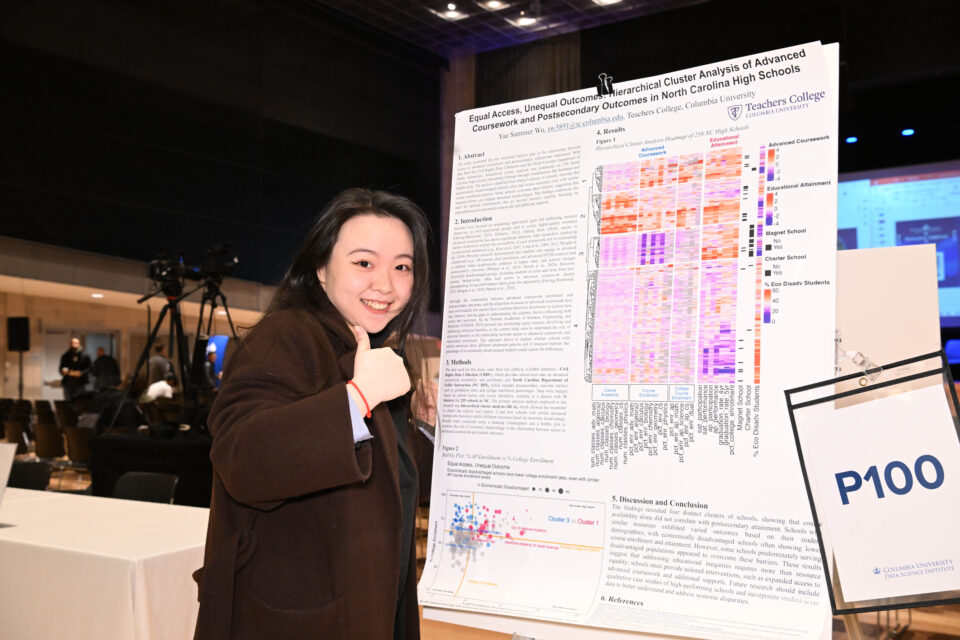

“We’re not here just to talk about what AI can do,” said Garud Iyengar, the Avanessians Director of the Data Science Institute and Professor of Engineering and Operations Research. “We’re here to talk about what it should do.” That framing shaped the agenda at Columbia’s Data Science Day 2025, an event that drew 450+ attendees to Alfred Lerner Hall on April 2.
Hosted by DSI, the event welcomed industry leaders and members of the broader public to join researchers from across Columbia University to explore how data science is being applied in systems that shape everyday life—health care, infrastructure, energy, media, and beyond. The day’s focus was not just technical advancement, but how research aligns with application, accountability, and social impact.

Here are five takeaways from the day:
1. Columbia is building for interdisciplinary impact — not silos.
In her opening remarks, Provost Angela Olinto described DSI as the home of Columbia’s AI Initiative, connecting schools and coordinating research across the university. The day’s discussions made that model visible. Faculty shared work on AI-powered stroke rehabilitation, predictive hospital staffing, endometriosis symptom forecasting, and the use of climate data to improve solar and wind energy systems. These weren’t isolated technical contributions — they were responses to complex, cross-sectoral problems.

2. A keynote from industry brought a grounded view of what it takes to scale.
Keynote speaker Rick Rioboli, Executive Vice President and CTO at Comcast Connectivity and Platforms, offered an industry perspective on the challenges of moving from research to deployment—highlighting the organizational and infrastructural realities that shape how AI systems scale in practice. The theme resonated across the day: implementation depends on structure, not just invention.

3. At Columbia, health care is a proving ground for the impact of AI.
Several panels illustrated what it means to embed AI in sensitive, high-stakes environments. Professor Carri Chan shared research on adaptive staffing models in ICUs. Noémie Elhadad described digital tools co-developed with endometriosis patients to help forecast symptom patterns and support daily management. Matei Ciocarlie demonstrated robotic assistive devices for stroke recovery, powered by tactile sensing and machine learning. Across projects, the emphasis was on partnership — with clinicians, with patients, and with institutional systems.

4. To measure progress, we need to rethink key metrics.
In a panel on secure data systems, Professor Jason Healey of the School of International and Public Affairs challenged the field’s overreliance on surface-level metrics like attack volume or system uptime. His team is developing methods to evaluate cybersecurity resilience over time — a shift in perspective that applies well beyond digital security. As AI becomes embedded in critical social systems, understanding what “success” looks like is itself a research priority.

5. DSI is focused on impact across disciplinary boundaries.
The most compelling work on display crossed disciplinary boundaries. It brought together journalism and engineering, medicine and design, economics and policy. The projects shared a common thread: a focus on responsible innovation and long-term societal value—in line with Data Science Institute’s “Data for Good” mission.
In addition to the panels and keynotes, the poster session featured over 120 posters and demos spanning a range of domains: computing systems, cybersecurity, education, media, smart cities, and more. It offered a broad view of applied data science at Columbia—and of the institutional commitment to interdisciplinary problem-solving at scale.

The Takeaway:
As AI and data science move further into the systems that shape daily life, Columbia’s Data Science Institute is positioned to be a leader in advancing and applying them responsibly, through student work, faculty research, and industry partnership.